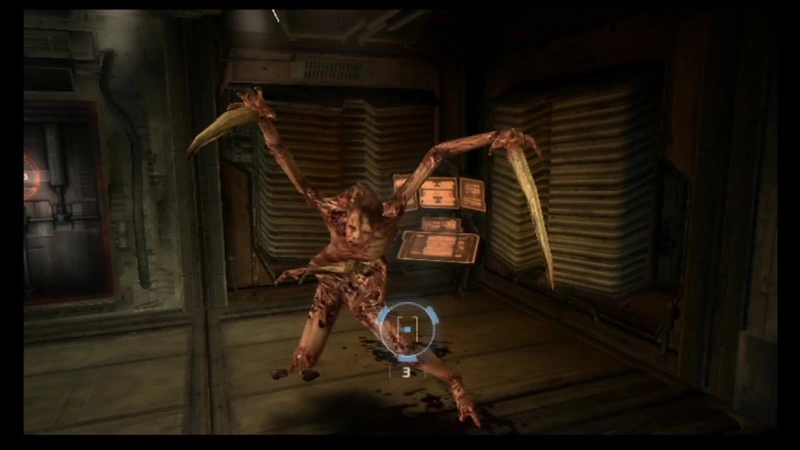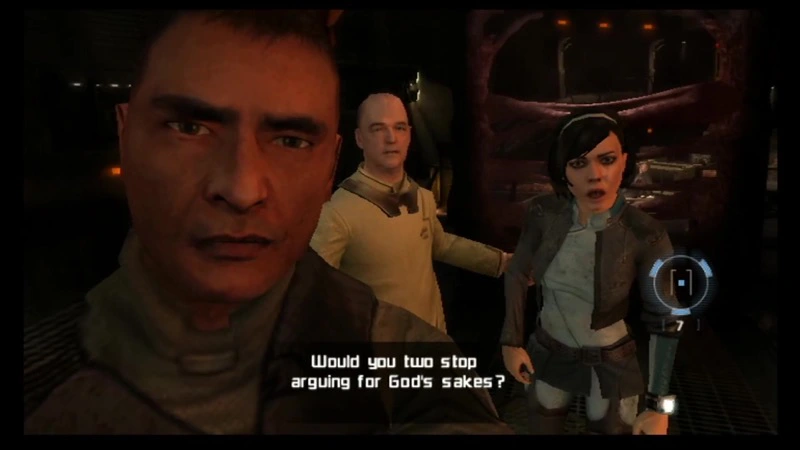by Dan McAlister

Score: 2/5
Platforms: Wii, PS3
Dead Space: Extraction is an action-horror game originally released for the Wii and later polished up for a PS3 port. It’s a prequel to the original Dead Space, but it has a major gameplay difference from its predecessor. The original Dead Space is a free roaming shooter where you explore a spaceship and get in firefights with zombie-like “necromorphs.” Dead Space: Extraction shares the space-bound setting, but takes the exploration out of it; it’s a rail shooter. Think House of the Dead, Timesplitters, or any cabinet at the arcade where you point a plastic gun at the screen. The game controls the player’s movement through a shooting gallery, while the player points the gun (or in my case, the Wii remote) and pulls the trigger.
I’m fond of rail shooters because they offer an interesting challenge: design by subtraction. As necromorphs barrel down a hallway at you, you no longer have the options of scrambling for cover, performing evasive maneuvers, or making a tactical retreat. You’re locked in place, but does that have to mean you have fewer choices? Is it the same shooter gameplay, but less? Dead Space: Extraction makes some novel adjustments to the rail shooter genre, changes that seem designed to take up the challenge of deepening what some might see as a simplistic kind of game. The ideas are mostly good, but the execution is mostly not.
The game starts with something not usually found in arcade-inspired games: a good deal of narrative. The story starts after the discovery of a “marker,” a kind of twisted obsidian structure with strange markings, glowing red lights, and a bad vibe. These things are viewed differently depending on whether you’re a cultist who worships them as sacred relics, or a rational observer who looks at sinister glowing sculptures and assumes they occur naturally and are not a big deal. But personal perspective ends up not mattering so much when the marker starts emitting signals that zombify dead bodies. After that, everyone’s pretty equally done for.
The game’s ten levels shift the player between different point-of-view characters, most of whom are part of a core team of survivors. They’re all flat archetypes: McNeill (good cop) is there to be inoffensive. Weller (gruff cop) is there to tell Lexine “Sorry, sweetheart, but you can’t come with us ” so that McNeill can stick up for her. Lexine (“sweetheart”) is love-interested in McNeill. As for Eckhardt (company executive), I jotted down “definitely evil” as soon as we met and I never needed to update my notes on him after that. There are some other figures who drift into the plot as needed, but they’re all cannon fodder, usually dispatched within minutes of arriving. It conditioned me not to emotionally invest in any “new friends”, and to not be scared for them either. When a fresh character’s head rolled past me in a later chapter, I just laughed.

While the details of the story are uninteresting, the execution holds a lot of promise. The game’s camera, rather than scanning smoothly like a classic rail shooter or Disneyland automoton attraction, mimics a terrified human motion. It bobs to accommodate a strained, rapid breath. It looks forward, then snaps back; what was that darting shadow? A necromorph knocks your character to the ground, creating something rare in a game, an upward perspective from a flat back. In a story bereft of interest, the camera operator is giving their all.
The player-controlled mechanics also introduce a lot of possibility, but are underutilized. My favorite of these is the glow worm, a luminescent stick used to explore dark passageways (and presumably space-raves, which are not present in this title). Give the Wii remote a shake, and your glow worm lights up the dark, revealing surroundings and potential enemies, if only for thirty seconds or so. But here’s the catch: if you’re shaking the Wii remote, you’re not pointing it at the screen. If enemies are advancing on you in the dark, are you better off shooting blindly, or charging your light while the unknown creeps ever closer? It’s a great question for the game to ask the player, but Extraction only asked it of me once, in the penultimate level. That was the only time an encounter in the dark lasted long enough that my light went out, making me revisit that decision again and again while wondering how many more necromorphs were still coming around the corner. Every other time I needed to use the glow worm, enemies attacked me in more considerate ones and twos.
Extraction shows plenty more ingenuity for mechanics, but the implementation never matches up to the idea. Telekinesis lets you pick up objects from the environment to pitch at enemies, but ammo pickups for your weapons are so generous that it’s rarely worth the effort. A dismemberment system places emphasis on shooting limbs off of zombies, opening up possibilities for creative play. But shooting a zombie’s legs out quickly becomes second nature, and zombies aren’t thrilling when they have to slowly pull themselves along the ground and you have a machine gun. Each weapon has an “alt-fire” mode that creates a different effect when you turn the Wii remote sideways, but the default mode is always more versatile and more than sufficient.
Some of these problems might not exist on the harder difficulty levels. The game gives you two options for difficulty at the beginning, “Normal” and “Hard,” and locks off two more challenging options until after you beat the game. It’s likely that playing on “Impossible” forces you to conserve ammo, use more telekinesis, or be more precise when de-limbing a necromorph, but I’ll never know. Gating off higher difficulty levels only encourages replays when the first experience was engaging. Mine wasn’t.
The updates that Dead Space: Extraction brings to the rail shooter formula are well meaning, but their execution is too flawed, bogging down the experience at best and undercutting the strengths of the genre at worst. The time spent on a story that doesn’t work is a drag. The amount of power granted to the player sucks any fear or excitement out of being locked on a space ship full of zombies. Every gameplay option, be it glow worms or dismemberment, quickly becomes automatic. None of the innovations here do much to create interesting player choice.
There’s a lot here that could work if applied differently. It’s a pile of limbs, twitching on the floor. Maybe in a different game they could pull themselves into a more compelling shape, either exciting or terrifying. But today, in this game, they don’t amount to enough.
Pilediver is a review series where I play through the many, many games in my backlog. Thank you for reading.
The opinions in this post are expressly the views of the author and do not reflect the views of their employer(s) or any entities that they might otherwise be affiliated.